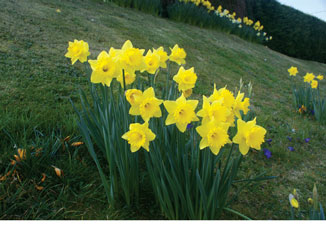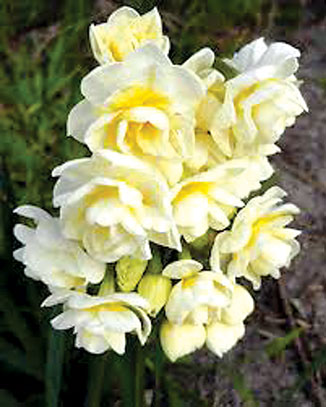As soon as a splash of yellow appears I know spring is on its way. The bright, nodding blooms signal the end of winter’s dark days, reminding us of the joys a new season will bring. It’s not surprising the Cancer Society of New Zealand use the daffodil as their symbol – it represents hope.
Daffodils are easy to grow and require little attention. They are one of our most popular spring-flowering bulbs, and whether you call then narcissus, or daffodil, it really doesn’t matter. Narcissus is the Latin or botanical name for all daffodils and jonquils – daffodil is the common name for all members of the genus narcissus.
My favourite is “King Alfred”, a traditional yellow, plain, long trumpet type. This giant daffodil was first raised in 1890, and named after one of England’s greatest medieval kings. “St Issey”, an early flowering new-comer, has a long stem similar to King Alfred and a large yellow cup – even older than King Alfred are the fragrant double daffodils, Narcissus “Telmoneus Plenus”.
The dainty, miniature Narcissus bulbocodiu “Citrinus” has bright golden trumpets which open wide, giving the appearance of hoop petticoats. Narcissus cantabricus, another miniature hoop petticoat, has solitary, pure white blooms with small, pointed petals and open trumpets that appear on leafless stems. Although miniature daffodils move easily in the breeze, and look delicate, they are actually quite sturdy, and look delightful at the front of a border.
Golden-eyed “Soleil d’Or” looks great in molten drifts under deciduous trees, or planted randomly in grassy, undisturbed areas. This highly-scented, vigorous daffodil was raised many centuries ago, and produces multi-headed blooms with orange-red trumpets.
The all-time fragrant favourite must be “Earlicheer” with its fluffy, double, creamy-white flowers. Plant this gorgeous daffodil somewhere close, where you can appreciate the highly scented blooms.
When selecting bulbs make sure they are firm, and generally speaking, the larger the bulb, the better the flowering. Plant in a well-drained soil in early autumn, and bury twice as deep as their width. Before planting add peat, compost or well-rotted organic matter, and it’s also a good idea to mix in some bulb food. Make sure you protect new shoots from rampaging slugs and snails!
Daffodils prefer full sun, although they will flower in light shade. They can be left undisturbed for several years, and only need lifting and dividing when over-crowded. Don’t be tempted to tidy up and cut the foliage back, as leaves contain the bulb food supply for following season. Tie foliage in a knot, or fold foliage over and secure with rubber band. If you hate the messy look, disguise by planting annuals and perennials around bulbs. After foliage has dried naturally, it can be removed.
Daffodils also look spectacular in containers, particularly the miniatures. Use a quality potting mix and water regularly. Place the pot in a shady spot until shoots appear, and then bring out into full sun.
No matter where they grow, daffodils are one of the happiest flowers – those swaying heads of yellow, cream and orange make us smile.

